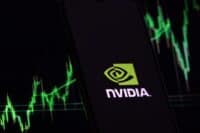

When Advanced Micro Devices Inc. (NASDAQ: AMD) reported earnings late last month, the numbers were not terribly impressive. The company posted $0.14 in earnings per share (EPS) and $1.79 billion in revenue, versus expectations for $0.18 in EPS and $1.78 billion in revenue.
Revenue rose 40% year over year in the quarter but fell 16% sequentially as sales of both its computer and graphics processors slipped. However, margins rose and operating income soared. The company’s comment that revenue was down quarter over quarter due to “lower revenue” didn’t really clarify much.
On the conference call, CEO Dr. Lisa Su attributed the lower revenues to softness in China due to the COVID-19 outbreak and the lockdown that began more than a month earlier than it did in the United States. Su also said that volume shipments were higher, as were average selling prices, and the company believes it “gained client unit market share for the 10th straight quarter.”
Still, the forces arrayed against AMD are formidable. On the CPU side, Intel Corp. (NASDAQ: INTC) has released its newest Core i9-10900K, which the company calls the “world’s fastest gaming processor.”
On the GPU side, Nvidia Corp. (NASDAQ: NVDA) continues to be AMD’s target. The good news for AMD is that Nvidia is losing traction in its game console business while AMD is gaining ground.
The Graphics Segment Battleground
Nvidia’s gaming segment revenues fell 10% sequentially in the first quarter while rising 27% year over year. That growth represents just a third of the growth in data center revenues.
Consolidating the now-completed $7 billion Mellanox acquisition is going to be Nvidia’s top priority for the second quarter. It has to be. After spending that kind of money, Nvidia has to get the integration right.
For AMD, that may open the door to the graphics segment somewhat. Because its gross margins are significantly lower than Nvidia’s, it has to grow its market share in what it calls its semi-custom business. This is the division that builds processors for Sony Corp.’s (NYSE: SNE) PlayStation 5 and Microsoft Corp.’s (NASDAQ: MSFT) Xbox Series X, both due for release in time for the 2020 holiday season.
With both Sony and Microsoft gearing up for new consoles, sales of semi-custom chips slipped. AMD might see lower margins here while the manufacturing process for new gaming chips is ramped up.
In the first quarter, AMD GPU unit shipments and revenue both grew by a double-digit percentage year over year, driven largely by sales of its Radeon RX 5000 series, desktop and notebook GPUs.
The company’s latest and greatest graphics processor is the Radeon Pro VII GPU. The chip is aimed at the artificial intelligence (AI) and machine learning market, where higher performance is the never-ending goal. The new Radeon chip reportedly will be priced at around $1,900. Nvidia’s comparable Tesla V100 has a list price of more than $10,000.
Overall, in the first quarter, AMD reported a gross margin of 46%, compared to Nvidia’s 65% gross margin. An order of magnitude price differential can’t withstand that kind of pressure for long.
What the Analysts Say
One of the most impressive things about AMD’s first-quarter report was its guidance. Not that it was magnificent, but that it was present at all. Most companies are tearing up fiscal year guidance as a result of the coronavirus pandemic.
The Wedbush analyst interpreted the guidance as evidence that AMD was being “very conservative” in its projections. Wedbush reiterated its Outperform rating and raised its price target from $57 to $60 a share.
Other analysts’ opinions ranged from lukewarm to medium hot. Credit Suisse reiterated a Neutral rating with a $33 price target. UBS also has a Neutral rating on the stock, but it raised its price target from $48 to $52.
Another Neutral rating came from analysts at JPMorgan, who raised the stock from a Sell rating. The price target went from $45 to $52 a share.
Nomura rates AMD a Buy with a price target of $64, and Piper Sandler reiterated an Overweight rating and raised its price target from $58 to $60. Wells Fargo reiterated an Equal Weight rating and raised its target from $50 to $55, while Rosenblatt Securities reiterated the stock as a Buy and raised its price target from $65 to $70.
Can AMD Hold Its Ground?
AMD is fighting a two-front battle against two heavily armed (with products and cash) competitors. Its primary weapons are price and price. Will shareholders, a notoriously shortsighted crowd, stick with AMD as it tries to maintain its wedge into Intel territory while at the same time releasing new products that challenge Nvidia in GPUs? Big ifs that could morph into big rewards for investors who stick with AMD for the next few quarters.
Sponsored: Want to Retire Early? Here’s a Great First Step
Want retirement to come a few years earlier than you’d planned? Or are you ready to retire now, but want an extra set of eyes on your finances?
Now you can speak with up to 3 financial experts in your area for FREE. By simply clicking here you can begin to match with financial professionals who can help you build your plan to retire early. And the best part? The first conversation with them is free.
Click here to match with up to 3 financial pros who would be excited to help you make financial decisions.
Thank you for reading! Have some feedback for us?
Contact the 24/7 Wall St. editorial team.
 24/7 Wall St.
24/7 Wall St.


